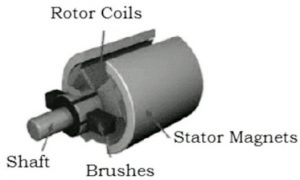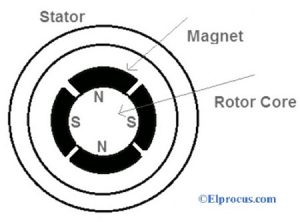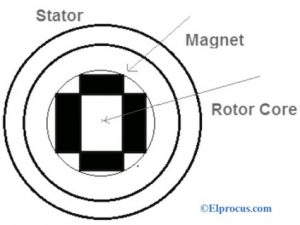
What is a Permanent Magnet Synchronous Motor & Its Working
In an electrical system, synchronous motors are the most widely used steady-state 3-phase AC motors, which convert electrical energy into mechanical energy. This type of motor operates at synchronous speed, which is constant and it is synchronous with the supply frequency and the period of rotation is equal to the integral no. of AC cycles. That means the speed of the motor is equal to the rotating magnetic field. This type of motor mainly used in power systems to improve the power factor. There are non-excited and DC excited synchronous motors, which operate according to the magnetic power of the motor. Reluctance motors, hysteresis motors, and permanent magnet motors are the non-excited synchronous motors. This article is all about the working of a permanent magnet synchronous motor.
The permanent magnet synchronous motors are one of the types of AC synchronous motors, where the field is excited by permanent magnets that generate sinusoidal back EMF. It contains a rotor and stator same as that of an induction motor, but a permanent magnet is used as a rotor to create a magnetic field. Hence there is no need to wound field winding on the rotor. It is also known as a 3-phase brushless permanent sine wave motor. The permanent magnet synchronous motor diagram is shown below.

The permanent magnet synchronous motors are very efficient, brushless, very fast, safe, and give high dynamic performance when compared to the conventional motors. It produces smooth torque, low noise and mainly used for high-speed applications like robotics. It is a 3-phase AC synchronous motor that runs at synchronous speed with the applied AC source.
Instead of using winding for the rotor, permanent magnets are mounted to create a rotating magnetic field. As there is no supply of DC source, these types of motors are very simple and less cost. It contains a stator with 3 windings installed on it and a rotor with a permanent magnet mounted to create field poles. The 3-phase input ac supply is given to the stator to start working.
The permanent magnet synchronous motor working principle is similar to the synchronous motor. It depends on the rotating magnetic field that generates electromotive force at synchronous speed. When the stator winding is energized by giving the 3-phase supply, a rotating magnetic field is created in between the air gaps.
This produces the torque when the rotor field poles hold the rotating magnetic field at synchronous speed and the rotor rotates continuously. As these motors are not self-starting motors, it is necessary to provide a variable frequency power supply.
In a synchronous machine, the average EMF induced per phase is called dynamic induces EMF in a synchronous motor, the flux cut by each conductor per revolution is Pϕ Weber
Then the time taken to complete one revolution is 60/N sec
The average EMF induced per conductor can be calculated by using
( PϕN / 60 ) x Zph = ( PϕN / 60 ) x 2Tph
Where Tph = Zph / 2
Therefore, the average EMF per phase is,
= 4 x ϕ x Tph x PN/120 = 4ϕfTph
Where Tph = no. Of turns connected in series per phase
ϕ = flux/pole in weber
P= no. Of poles
F= frequency in Hz
Zph= no. Of conductors connected in series per phase. = Zph/3
The EMF equation depends on the coils and the conductors on the stator. For this motor, distribution factor Kd and pitch factor Kp is also considered.
Hence, E = 4 x ϕ x f x Tph xKd x Kp
The torque equation of a permanent magnet synchronous motor is given as,
T = (3 x Eph x Iph x sinβ) / ωm
To control the permanent magnet synchronous motor, we use different types of control systems. Depending on the task, the necessary controlling technique is used. The different controlling methods of permanent magnet synchronous motor are,
Sinusoidal Category
Trapezoidal Category
Direct torque control technology of this motor is a very simple control circuit with effective dynamic performance and good control range. It doesn’t require any position sensor for the rotor. The main disadvantage of using this control method is, it produces high torque and a current ripple.
The permanent magnet synchronous motor construction is similar to the basic synchronous motor, but the only difference is with the rotor. The rotor doesn’t have any field winding, but the permanent magnets are used to create field poles. The permanent magnets used in the PMSM are made up of samarium-cobalt and medium, iron, and boron because of their higher permeability.
The most widely used permanent magnet is neodymium-boron-iron because of its effective cost and ease of availability. In this type, the permanent magnets are mounted on the rotor. Based on the mounting of the permanent magnet on the rotor, the construction of a permanent magnet synchronous motor is divided into two types. They are,
In this construction, the magnet is mounted on the surface of the rotor. It is suited for high-speed applications, as it is not robust. It provides a uniform air gap because the permeability of the permanent magnet and the air gap is the same. No reluctance torque, high dynamic performance, and suitable for high-speed devices like robotics and tool drives.

Buried PMSM or Interior PMSM
In this type of construction, the permanent magnet is embedded into the rotor as shown in the figure below. It is suitable for high-speed applications and gets robustness. Reluctance torque is due to the saliency of the motor.

The working of the permanent magnet synchronous motor is very simple, fast, and effective when compared to conventional motors. The working of PMSM depends on the rotating magnetic field of the stator and the constant magnetic field of the rotor. The permanent magnets are used as the rotor to create constant magnetic flux, operates and locks at synchronous speed. These types of motors are similar to brushless DC motors.
The phasor groups are formed by joining the windings of the stator with one another. These phasor groups are joined together to form different connections like a star, Delta, double and single phases. To reduce harmonic voltages, the windings should be wound shortly with each other.
When the 3-phase AC supply is given to the stator, it creates a rotating magnetic field and the constant magnetic field is induced due to the permanent magnet of the rotor. This rotor operates in synchronism with the synchronous speed. The whole working of the PMSM depends on the air gap between the stator and rotor with no load.
If the air gap is large, then the windage losses of the motor will be reduced. The field poles created by the permanent magnet are salient. The permanent magnet synchronous motors are not self-starting motors. So, it is necessary to control the variable frequency of the stator electronically.
The differences between permanent magnet synchronous motor (PMSM) and BLDC (brushless DC motors) include the following.
| Permanent Magnet Synchronous Motor |
BLDC |
| These are brushless AC synchronous motors | These are brushless DC motors |
| Torque ripples are absent | Torque ripples are present |
| Performance efficiency is high | Performance efficiency is low |
| More efficient | Less efficient |
| Used in industrial applications, automobiles, servo motors, robotics, train drives, etc | Used in electronic steering power systems, HVAC systems, hybrid train drives (electrical), etc |
| Produces low noise | Produces high noise. |
The advantages of permanent magnet synchronous motor include,
The disadvantages of permanent magnet synchronous motors are,
The permanent magnet synchronous motors applications are,
Thus, this is all about an overview of the permanent magnet synchronous motor – definition, working, working principle, diagram, construction, advantages, disadvantages, applications, emf, and torque equation. Here is a question for you, ” What is the purpose of using a permanent magnet in synchronous motors?
 Call at :
Call at :
Phone : +8613860661520
 Email Us :
Email Us :
Email : ivy@tech-zy.com
 Address :
Address :
Floor 16 Building#3, No.136. Kuiqi Road, Mawei District, Fuzhou City, Fujian Province, China
© Copyright: 2024 Fujian ZY Electric & Machinery Technology Co.,Ltd All Rights Reserved.

IPv6 network supported